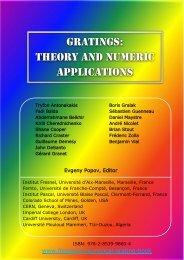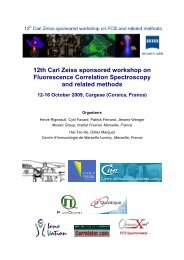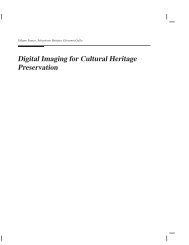My PhD dissertation - Institut Fresnel
My PhD dissertation - Institut Fresnel
My PhD dissertation - Institut Fresnel
You also want an ePaper? Increase the reach of your titles
YUMPU automatically turns print PDFs into web optimized ePapers that Google loves.
55<br />
To convert atropisomer Ia into Ib, it is necessary to supply the required free enthalpy<br />
of activation ∆G ≠ (Ia-Ib). The magnitude of this free enthalpy determines the rate of the<br />
thermally induced isomerization and is evidently depending on the temperature of study. The<br />
rate constant kr of this process is related to ∆G ≠ (Ia-Ib) in accordance with the Eyring equation,<br />
where T is the absolute temperature, R is the universal gas constant, kb is the Boltzmann's<br />
constant, h is Planck's constant and κ is the transmission coefficient:<br />
or<br />
k<br />
r<br />
∆<br />
= κ ⋅ k<br />
b<br />
⋅T<br />
⋅ h<br />
−1<br />
⎛ − ∆<br />
exp ⎜<br />
⎝ RT<br />
≠<br />
G( Ia - Ib)<br />
⎞<br />
⎟<br />
⎠<br />
⎡<br />
⎛ T ⎞⎤<br />
⋅T<br />
⎢10.<br />
321+<br />
log<br />
⎜<br />
⎟<br />
⎟⎥<br />
⎢⎣<br />
⎝ kr<br />
⎠⎥⎦<br />
≠<br />
−3<br />
G (Ia - Ib) = 4.<br />
57 ⋅10<br />
(kcal·mol -1 )<br />
Whenever rotation is too fast to allow isolation of isomers on laboratory time scale<br />
(i.e. ∆G ≠ (Ia-Ib) < 22 kcal·mol -1 ), rapid racemization processes in chiral biphenyls can be<br />
detected by NMR spectroscopy provided that the investigated substrate bears a diastereotopic<br />
pair of NMR-active nuclei (e.g. A = B = -CH2R with A ≠ C and B ≠ D). Under this condition,<br />
two types of magnetically non-equivalent hydrogens do exist, resulting from the hampered<br />
rotation about the biphenyl single bond. The intramolecular rotation can thus be revealed by<br />
the temperature dependence of the magnetic environment for the diastereotopic probes.<br />
Hence, at low temperature, "slow" isomerization leads to two separate NMR signals for both<br />
diastereotopic hydrogens whereas at higher temperature, "fast" rotation gives only one signal<br />
with an average chemical shift.<br />
W. L. Meyer and R.B. Meyer<br />
[ ] 209 reported the first example of temperature-<br />
dependent 1 H-NMR spectrum for "methylene-bearing" biphenyls. For instance, 2,2'-<br />
bis(acetoxymethyl)biphenyl (46) exhibited an AB quartet signal for the methylene hydrogens<br />
at ambient temperature, whereas the pattern collapse into a broad singlet at Tc = 94 °C<br />
(Figure 7).













